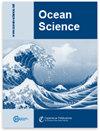Biophysical coupling of seasonal chlorophyll-a bloom variations and phytoplankton assemblages across the Peninsula Front in the Bransfield Strait
IF 4.1
3区 地球科学
Q2 METEOROLOGY & ATMOSPHERIC SCIENCES
引用次数: 1
Abstract
Abstract. This study investigates the spatio-temporal variations in the chlorophyll-a (chl-a) blooms in the Bransfield Strait (BS) at a climatological scale (1998–2018). We propose that suitable monitoring of these blooms can be achieved through remotely sensed observations only if the BS is divided following the Peninsula Front (PF), which ultimately influences the phytoplankton assemblage. Our analysis is based on characterizing climatological fields of sea surface temperature (SST), air temperature, sea ice coverage, chl-a concentrations and wind stress, guided by synoptic novel and historical in situ observations which reveal two niches for phytoplankton assemblage: the Transitional Bellingshausen Water (TBW) and Transitional Weddell Water (TWW) pools. The TBW pool features stratified, less saline, warmer waters with shallow mixed layers, while the TWW pool features well-mixed, saltier, and colder waters. We identify that the 0.6 °C isotherm corresponds to the summertime climatological PF location, effectively dividing the BS into two different scenarios. Furthermore, the 0.5 mg m−3 chl-a isoline aligns well with the 0.6 °C isotherm, serving as a threshold for chl-a blooms of the highest concentrations around the South Shetland Islands. For the first time, these thresholds enable the monthly climatological descriptions of the two blooms developing in the BS on both sides of the PF. We think this approach underscores the potential of combining SST and chl-a data to monitor the year-to-year interplay of the chl-a blooms occurring in the TBW and TWW pools contoured by the PF.布兰斯菲尔德海峡半岛前沿叶绿素-a 水华季节性变化与浮游植物组合的生物物理耦合关系
摘要本研究调查了布兰斯菲尔德海峡(BS)叶绿素-a(chl-a)藻华在气候尺度上的时空变化(1998-2018 年)。我们提出,只有在半岛前沿(PF)之后对布兰斯菲尔德海峡(BS)进行划分,才能通过遥感观测对这些水华进行适当的监测。我们的分析基于对海面温度(SST)、气温、海冰覆盖率、藻蓝蛋白浓度和风压等气候场特征的分析,以新颖的综合观测数据和历史原位观测数据为指导,揭示了浮游植物群的两个龛位:过渡贝林斯豪森水池(TBW)和过渡韦德尔水池(TWW)。贝林斯豪森过渡水域(TBW)和威德尔过渡水域(TWW)的特点是分层、盐度较低、水温较高且混合层较浅,而威德尔过渡水域(TWW)的特点是混合良好、盐度较高且水温较低。我们确定 0.6 °C 等温线与夏季气候 PF 位置相对应,从而有效地将 BS 划分为两种不同的情况。此外,0.5 mg m-3 chl-a 隔离线与 0.6 °C 等温线非常吻合,可作为南设得兰群岛附近最高浓度 chl-a 水华的阈值。这些阈值首次实现了对南设得兰群岛两侧 BS 中出现的两种水华的月气候描述。我们认为,这种方法强调了结合 SST 和 chl-a 数据来监测 PF 所勾勒的 TBW 和 TWW 池中发生的 chl-a 水华逐年相互作用的潜力。
本文章由计算机程序翻译,如有差异,请以英文原文为准。
求助全文
约1分钟内获得全文
求助全文
来源期刊

Ocean Science
地学-海洋学
CiteScore
5.90
自引率
6.20%
发文量
78
审稿时长
6-12 weeks
期刊介绍:
Ocean Science (OS) is a not-for-profit international open-access scientific journal dedicated to the publication and discussion of research articles, short communications, and review papers on all aspects of ocean science: experimental, theoretical, and laboratory. The primary objective is to publish a very high-quality scientific journal with free Internet-based access for researchers and other interested people throughout the world.
Electronic submission of articles is used to keep publication costs to a minimum. The costs will be covered by a moderate per-page charge paid by the authors. The peer-review process also makes use of the Internet. It includes an 8-week online discussion period with the original submitted manuscript and all comments. If accepted, the final revised paper will be published online.
Ocean Science covers the following fields: ocean physics (i.e. ocean structure, circulation, tides, and internal waves); ocean chemistry; biological oceanography; air–sea interactions; ocean models – physical, chemical, biological, and biochemical; coastal and shelf edge processes; paleooceanography.
 求助内容:
求助内容: 应助结果提醒方式:
应助结果提醒方式:


